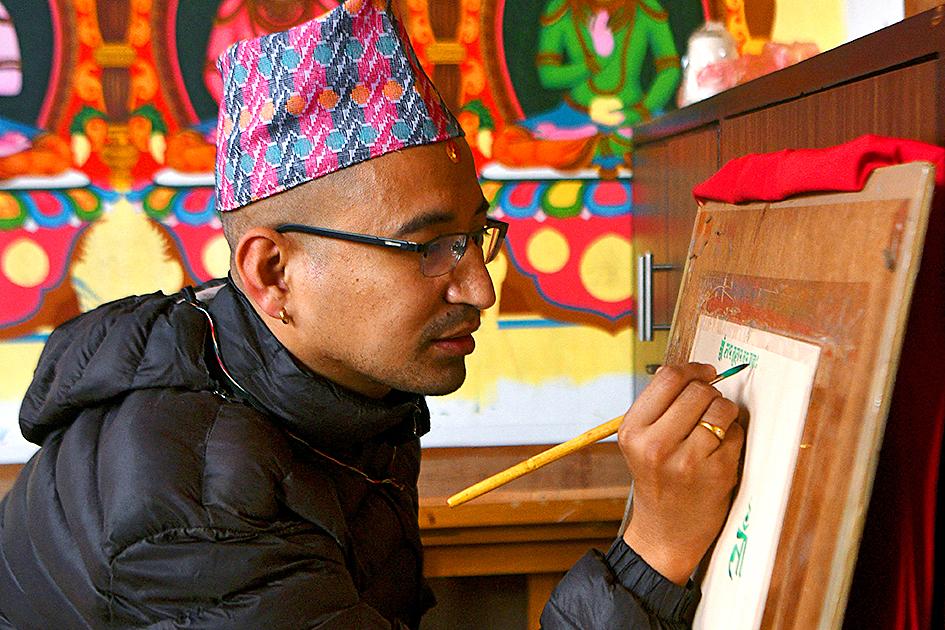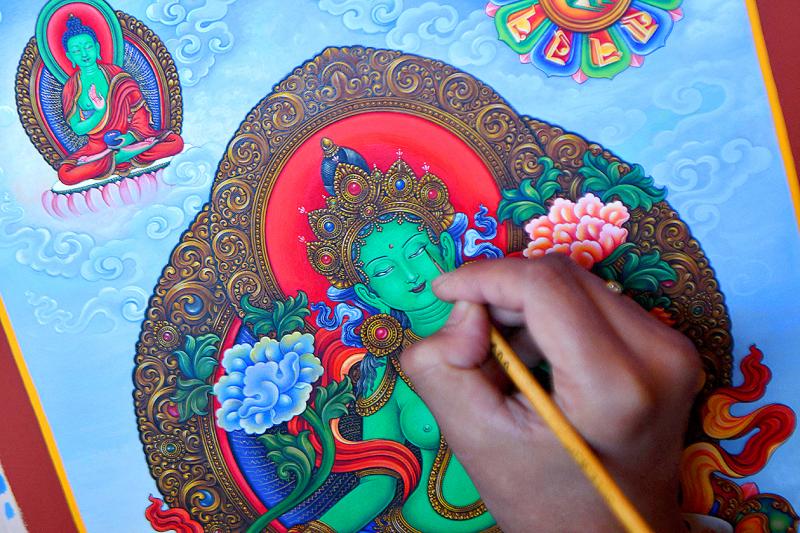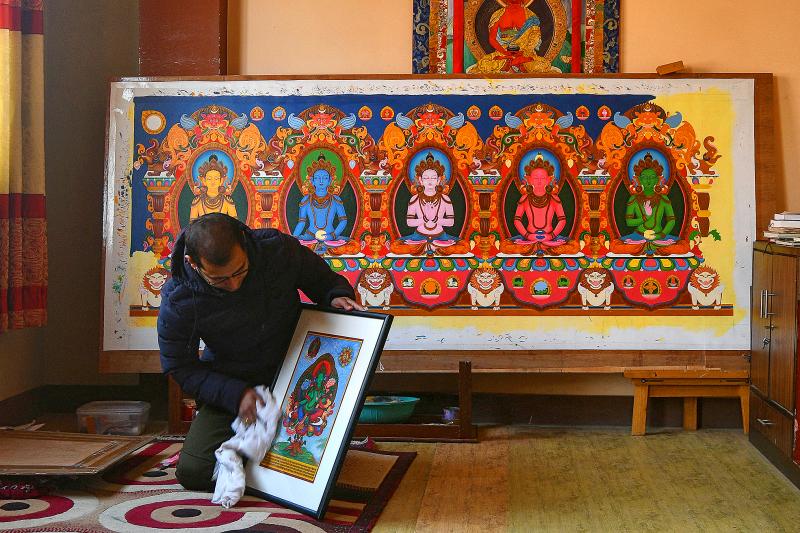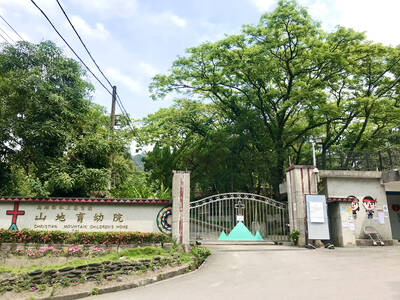With a shaved head and an empty stomach, artist Ujay Bajracharya dips his brush to line the eyes of the deity Tara as a soothing Buddhist hymn warbles in the background.
The 40-year-old is applying the final strokes to his paubha painting, a devotional art form known for its minute detail, intense colors and the strict purification rituals traditionally required of its practitioners. It took three months for Bajracharya to complete his rendition of the Green Tara, a goddess of compassion revered by Buddhists and Hindus in Nepal.
Before work began, he shaved off his hair and clipped his nails, while a Buddhist priest blessed his canvas and selected a day auspicious enough for the artist to commence his labors.

Photo: AFP
Bajracharya woke up early each morning and did not eat until his day’s work was over, adopting a strict vegetarian diet that also excluded garlic, tomatoes and onion when he broke his fast.
“My body felt light and I felt more focused and motivated to paint,” he said. “Changing my lifestyle was a bit difficult at first but I had the support of my family and friends, so that helped me stay disciplined.”
Paubha remains a common painting method in Nepal but the austere religious observances once followed by its artists have fallen out of practice.

Photo: AFP
Bajracharya’s adoption of these rituals began last year, when he approached a museum in the capital Kathmandu about painting another Buddhist deity while adhering to the forgotten traditions.
Rajan Shakya, founder of the Museum of Nepali Art, said that they immediately agreed to the idea of reviving the practice.
“It is part of what makes paubha art unique and valuable. The more people learn about it, the more demand there will be for Nepali artists. And then we know our art will survive, our culture will survive,” Shakya said.

Photo: AFP
Bajracharya has committed to observing these rules for future paintings, beginning with his exacting work on the Green Tara, which he crafted for worship in a private prayer room at his home.
“I felt that we should preserve this method and the next generation should also be aware — people should know about the spiritual aspect of these paintings,” he said.
Paubha artworks use cotton or silk canvases, and colors were traditionally made by grinding minerals and plants into fine powder. Some works even used pure gold and silver.
The oldest preserved paubha painting dates to the 13th century, but scholars believe the tradition is much older, with earlier examples likely disappearing because of the fragile materials used.
Its artists are believed to have inspired trends in thangkas, a similar type of devotional painting in neighboring Tibet that has been recognized in UNESCO’s list of intangible cultural heritage.
‘A FORM OF MEDITATION’
Priest Dipak Bajracharya — a member of Ujay’s caste but of no relation to the painter — said that in earlier times paubha artists would stay “pure” to ensure the sanctity of the images they produced.
“The process itself is considered a form of meditation,” he said.
While the traditional religious value remains, paubha paintings are now commonly seen as decorative hangings in museums or the homes of collectors.
A growing international appreciation for the craft has proven lucrative for artists, with interested buyers in China, Japan and Western countries.
“Paubha paintings have now become a business, but their aim is not commercial — they are actually objects of respect and worship,” the priest said.
Dipak returned to Ujay’s home once the latter’s hair had grown back for a final religious ceremony, culminating in a ritual to “breathe life” into the finished painting.
The ceremonial practice invites the Green Tara to reside in the work as a vessel for worship.
“This is not art alone, the faith of Buddhists and Hindus is tied to it,” said Ujay Bajracharya. “If we don’t preserve this art form, the faith will also slowly fade away.”

May 18 to May 24 Pastor Yang Hsu’s (楊煦) congregation was shocked upon seeing the land he chose to build his orphanage. It was surrounded by mountains on three sides, and the only way to access it was to cross a river by foot. The soil was poor due to runoff, and large rocks strewn across the plot prevented much from growing. In addition, there was no running water or electricity. But it was all Yang could afford. He and his Indigenous Atayal wife Lin Feng-ying (林鳳英) had already been caring for 24 orphans in their home, and they were in

President William Lai (賴清德) yesterday delivered an address marking the first anniversary of his presidency. In the speech, Lai affirmed Taiwan’s global role in technology, trade and security. He announced economic and national security initiatives, and emphasized democratic values and cross-party cooperation. The following is the full text of his speech: Yesterday, outside of Beida Elementary School in New Taipei City’s Sanxia District (三峽), there was a major traffic accident that, sadly, claimed several lives and resulted in multiple injuries. The Executive Yuan immediately formed a task force, and last night I personally visited the victims in hospital. Central government agencies and the

Australia’s ABC last week published a piece on the recall campaign. The article emphasized the divisions in Taiwanese society and blamed the recall for worsening them. It quotes a supporter of the Taiwan People’s Party (TPP) as saying “I’m 43 years old, born and raised here, and I’ve never seen the country this divided in my entire life.” Apparently, as an adult, she slept through the post-election violence in 2000 and 2004 by the Chinese Nationalist Party (KMT), the veiled coup threats by the military when Chen Shui-bian (陳水扁) became president, the 2006 Red Shirt protests against him ginned up by

As with most of northern Thailand’s Chinese Nationalist Party (KMT) settlements, the village of Arunothai was only given a Thai name once the Thai government began in the 1970s to assert control over the border region and initiate a decades-long process of political integration. The village’s original name, bestowed by its Yunnanese founders when they first settled the valley in the late 1960s, was a Chinese name, Dagudi (大谷地), which literally translates as “a place for threshing rice.” At that time, these village founders did not know how permanent their settlement would be. Most of Arunothai’s first generation were soldiers